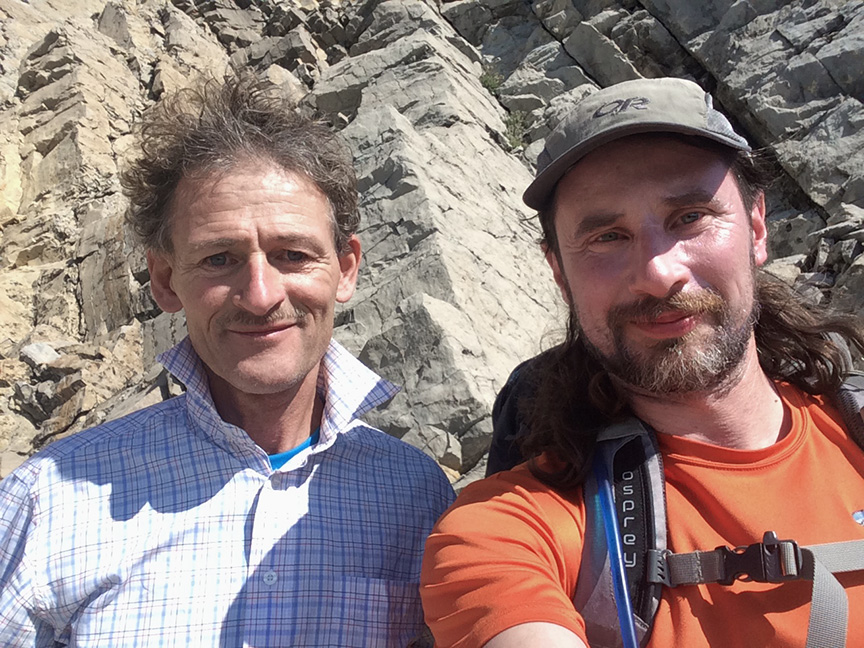360 degree panorama from the summit of Mount Borah, Idaho during the total solar eclipse of 2017.
Summit date: August 21, 2017
CONCEPTION AND PLANNING
It was about eight years ago that I first had the notion of photographing an eclipse from a state highpoint for my panorama series. I was thinking about what I could do that would be different, unique. I thought shooting an eclipse from a highpoint would fit the bill. I got on NASA’s website and started researching when the next appropriate eclipse would be. The U.S. wasn’t scheduled for an eclipse until 2017, almost eight years away.
The eclipse would be at least partially visible from all of the lower 48 states. The path of totality, where the moon completely blocks out the sun, however, was only visible from just over a dozen states. And of those states, only five would have the path of totality passing directly over their highpoint: Idaho, Wyoming, Tennessee, Georgia, and South Carolina.
At the time I had not yet done any of the five potential highpoints, but one of them in particular stood out; Idaho’s Mount Borah. The three eastern highpoints are all easily reached and I figured would be crowded. Tennessee’s highpoint for example, Clingman’s Dome, is in Great Smoky Mountains National Park, which is the nation’s most visited national park even on a slow day. They would also be more prone to low lying cloud cover. Wyoming’s highpoint, Gannett Peak, is notoriously difficult to get to involving a multi day trek, hiring guides, and permits for passing through native lands. Targeting a two and a half minute window to be on summit would be tough to say the least. With Borah standing at 12,662 feet it would certainly be an excellent vantage point to watch it. It was also doable as a day hike but was still daunting enough to keep away the huge crowds, and it was the first state highpoint in the path of totality. My sights were set. Idaho it was.
Over the years I would revisit my plans and tweak them, planning for not only the eclipse, but for other points of interest while I was out there. Kings Peak, the Utah highpoint, looked like a viable option for another highpoint to climb while I would be in the area.
Five years ago, while I was working on my bachelor’s degree from Empire State University, one of my professors suggested I apply for a big art fellowship grant that was to be awarded to a SUNY arts student. It was open to all art disciplines and degree levels. I submitted a portfolio of my highpoint and tri-point panorama photography. I made it through the early selection process. The next stage was to actually show my work and interview with the judges. I put up an exhibit of my work exclusively for the judges. During the interview one of the judges asked where I saw myself in five years. I responded that on August 21st of 2017 at 11:31 a.m. I would be on top of the highest mountain in Idaho to photograph a total solar eclipse. He laughed and said that was the most specific answer he had ever been given to that question. Two days later I got the call that I had won the grant.
In 2016, while climbing the Montana highpoint Granite Peak, I brought up the idea to one of the fellow hikers in my group. He was already well aware of the Borah eclipse and was planning on it himself. We tentatively agreed to meet up for it. This was my first indication that I was not, in fact, the only person planning on doing this. I would later meet a guy at my local rock climbing gym that was also planning on it. And here I thought I would have the mountain all to myself. I started adjusting my vision for the image I wanted to shoot and planned to incorporate the other people who would inevitably be on summit with me.
It wasn’t until I made my plane, rental car, and camping reservations in early 2017 that I finally had the feeling of “this is really happening”. The one thing that was worrying me about the whole thing was the weather. Weather was the one thing that could totally ruin the whole trip. My experience on Mount Katahdin in 2013 showed me that bad weather can indeed keep you from reaching the top. As I really had no back up plan for viewing the eclipse, I was keeping my fingers crossed and hoping for the best. Worse case scenario is that I would still be able to see everything get dark, even if I couldn’t see the eclipse itself.
ARRIVAL: GOOD FORTUNE AT TRAILHEAD
On August 19th, 2017, I was dropped off at the airport in Syracuse for my flight to Salt Lake City. A plan years in the making was finally getting under way. I tried to stop worrying about the weather. I couldn’t do anything about. If it was good then I’d go for it. If it was bad then I wouldn’t. Simple as that.
On August, 20th, the day before the eclipse, I made my way from Salt Lake City north to the Borah trailhead. The northbound traffic on Route 15 out of Salt Lake City was fairly heavy with all the people heading for the path of totality. I was happy to see far less traffic once I got off of Route 15 in Blackfoot, Idaho.
Although I had a campsite reserved in Challis, a 45 minute drive north of Mount Borah, I stopped by the trailhead to see if maybe there were any spots. The official campground was packed full, of course, but the BLM was allowing people to park and camp along the approach road just below the campground. This was excellent news! I had fully expected to have to make the drive from Challis, but now I was just a ten minute walk from the trailhead. This meant I could get a nice early start the next morning. I claimed my spot and spent the rest of the day walking around the area and talking to fellow eclipse watchers. There was a father and son parked behind me from California that I chatted with for a while.
Mount Borah from my campsite on the approach road a day before the eclipse. The summit can be seen along with a little sliver of the snow couloir in the upper right.
ASCENT: SIX DARK HOURS OF NOTHING BUT UP
That nice early start came at 12:30 a.m. when I woke up to start getting ready. The stars were out so I knew the sky was clear. An excellent sign and quite a relief. I made a hot breakfast and psyched myself up for the long day ahead.
The following video is me sitting in my car getting ready for the long day ahead.
Around 2:00 a.m. I stood at the wooden gate at the trailhead with a fresh set of batteries in my headlamp and my day pack all packed. I paused for a moment, staring into the darkness ahead of me. After eight years of thinking about it and planning it and worrying about every detail and hoping the weather cooperated, here it was, the day had arrived. Under a crystal clear sky full of stars, I took that first step onto the trail. I was finally doing it.
The early solo start meant I could go at my own pace, with plenty of time to get to the top. Totality was around 11:30 a.m., so I was giving myself nine and a half hours for the one way hike to the summit. I can really motor on flats and light hills, but steep inclines really slow me down, and Borah is nothing but up. 5,250 feet of elevation gain in just 3.5 miles to be exact. Average round trip times are listed as seven to twelve hours, so I felt I had plenty of time. I took it one step at a time, resting as needed.
One interesting thing I saw on the way up were ants. Normally I wouldn’t think twice about them, but these ones seemed to be… frozen. I would see lines of ants every couple dozen yards that just weren’t moving. I thought they were dead at first, but I touched one and it moved away from me, only to freeze in place again. It was the oddest thing. I’m guessing the cold overnight temperatures makes them super sluggish and they’ll start moving again once the sun comes up.
The following video shows the ants on the trail not moving
The early start also meant I’d be doing more than three quarters of the hike in the dark. In a way this was good since I had no sense of the scale of the mountain and I could just concentrate on the trail directly in front of me. Sometimes I could see the headlamps of hikers ahead of me in the distance and I could tell I still had a ways to go. And if I looked behind me I could see the headlights of cars coming up the approach road with more hikers arriving to get their 4:00 a.m. and 5:00 a.m. starts. Other than that I really had no idea what was around me. I knew I had hiked through trees for a while. On the ridgeline above the trees I looked over to my left and my headlamp caught the edge of the ridge which plummeted down quite a ways, farther than my headlamp could illuminate. The infamous Chicken-Out-Ridge, which turns many hikers back, seemed like no big deal in the dark.
It wasn’t until the snow couloir at three miles and about four hours into the hike that I finally turned off my headlamp and I could start to see what I had just climbed and what I still had left. I wouldn’t make it in time for sun rise from the summit, but I stopped on the saddle below the summit for some amazing views of the rising sun over the Sawtooth Mountains.
After four hours in the dark, this was my first glimpse of what I had just hiked up. The trail follows the top of that ridge, and the forest isn't visible from here.
Sunrise from the saddle below the summit
By 8:00 a.m., after six hours of dragging myself up one of the steepest climbs in my life, I had reached the top. I was tired and sore, but I had made it! There was plenty of time to spare with over two hours until the eclipse hit first contact. And I wasn’t alone.
"There is nothing more to see, you can go home now." A little summit humor.
SUMMIT: PARTY AT 12,600'
There was already a crowd gathering when I got there, and they just kept coming. There was a small group of hikers that were bundled up in their sleeping bags right on top of the summit. I had heard of people leaving for the summit as early as midnight. And there had been people camped out along the way, which I didn’t even realize was an option.
Conditions when I got to the summit were absolutely perfect. There wasn’t a cloud in the sky. It was cool, but not as cold as I was expecting. There was hardly even a breeze. The views were stunning. While the air at the higher elevations was clear, forest fires far to the west had sent a layer of haze which filled in the valleys far below, giving everything an otherworldly feel.
I met and talked with several people while waiting for the eclipse to start. There were people from all over the place. There was a man from Eastern Canada, another from Florida. There was even a family from Austria. I ran into my neighbors from base camp, the father and son. One man that definitely stood out was Jeff Zausch. He summited shortly after I did, wearing a bright red, white, and blue jacket. He then promptly stripped down to just his boots and a jockstrap with a big furry ‘coon tail on it. I found out that he was on an episode of the TV show “Naked and Afraid” and is the current star of Discovery Channel’s “Dual Survival”. I know I tend to have good luck running into celebrities, but I certainly wasn’t expected to see any here.
The following gallery show the crowd that gathered on summit.

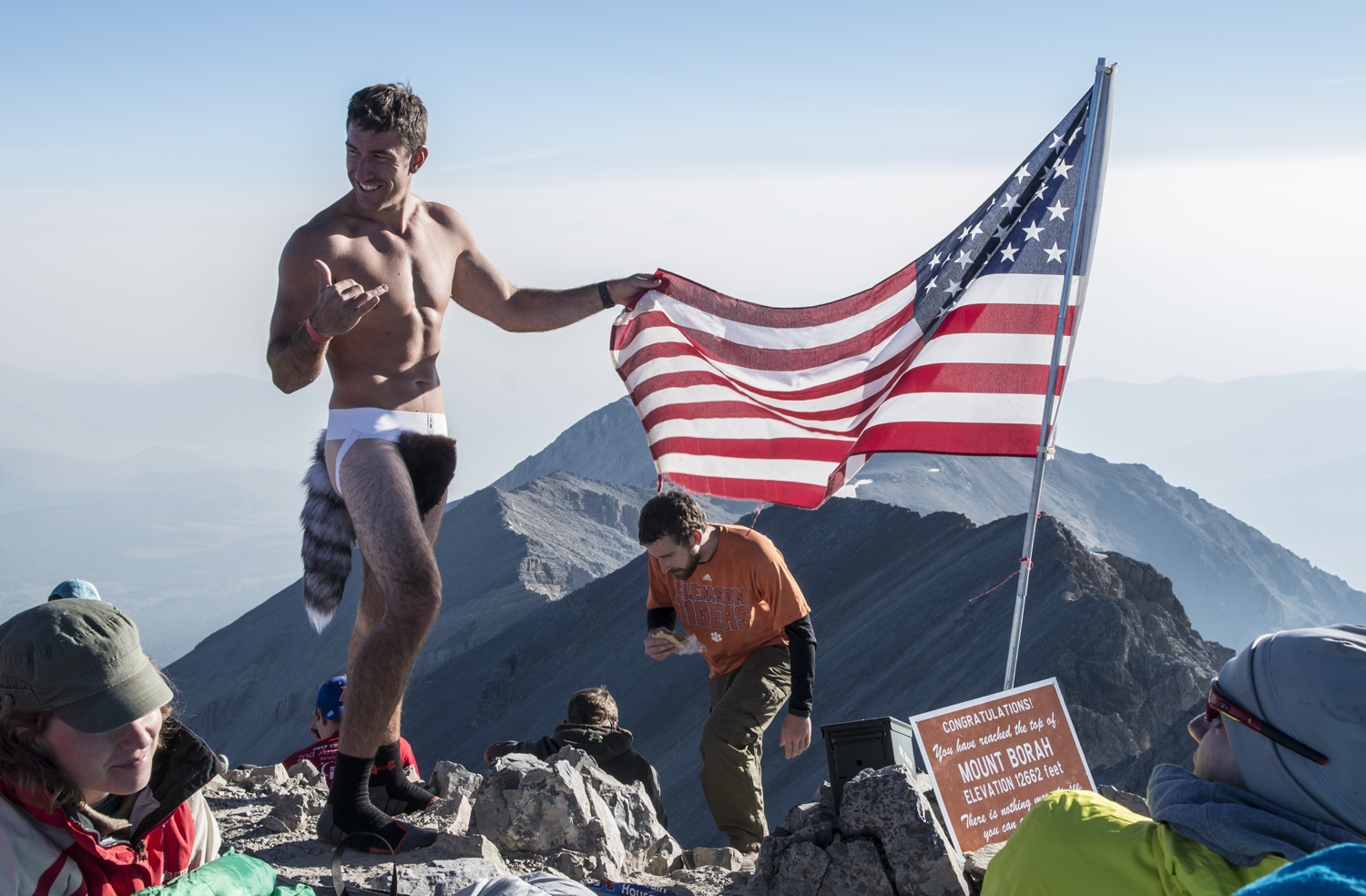
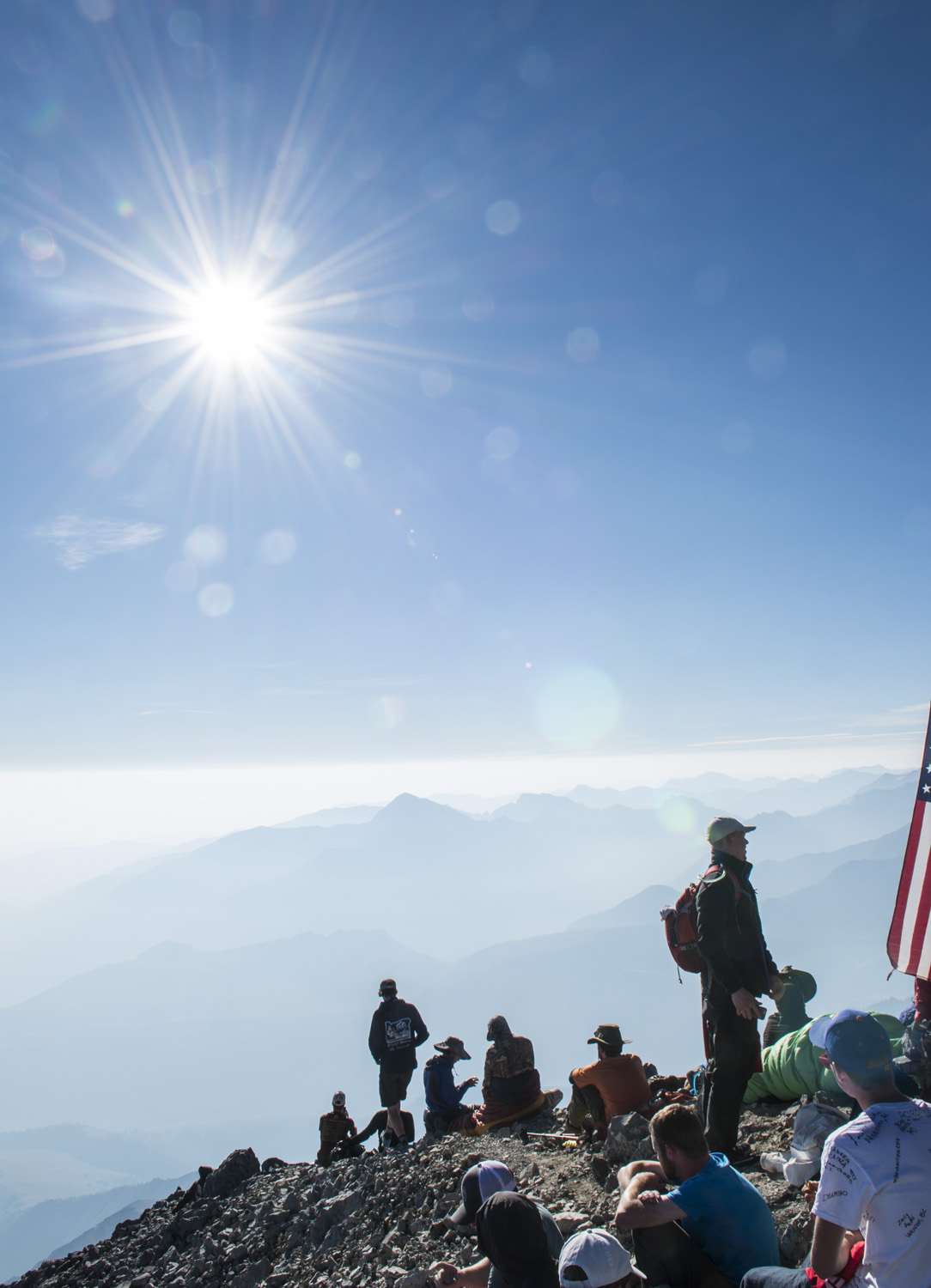
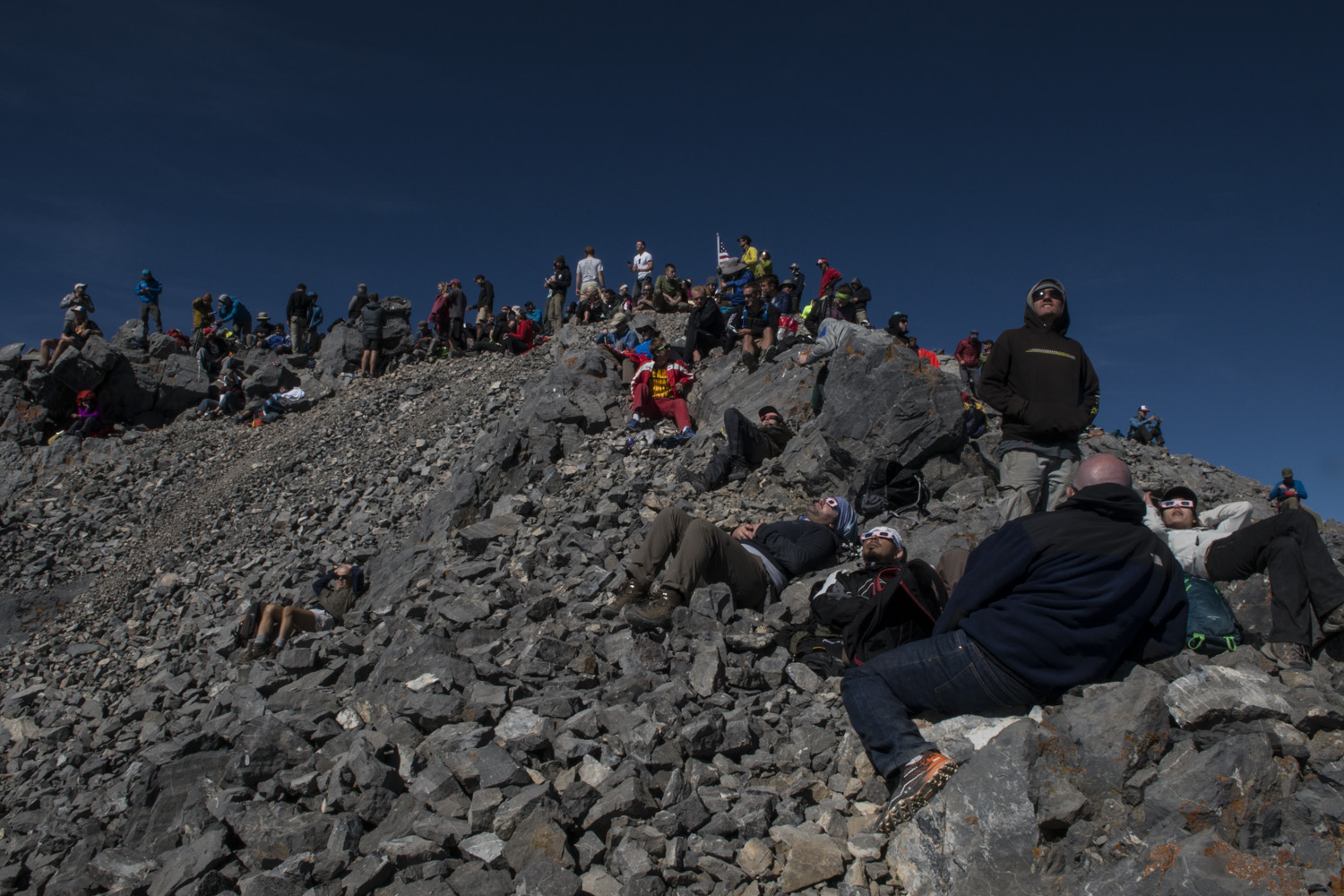
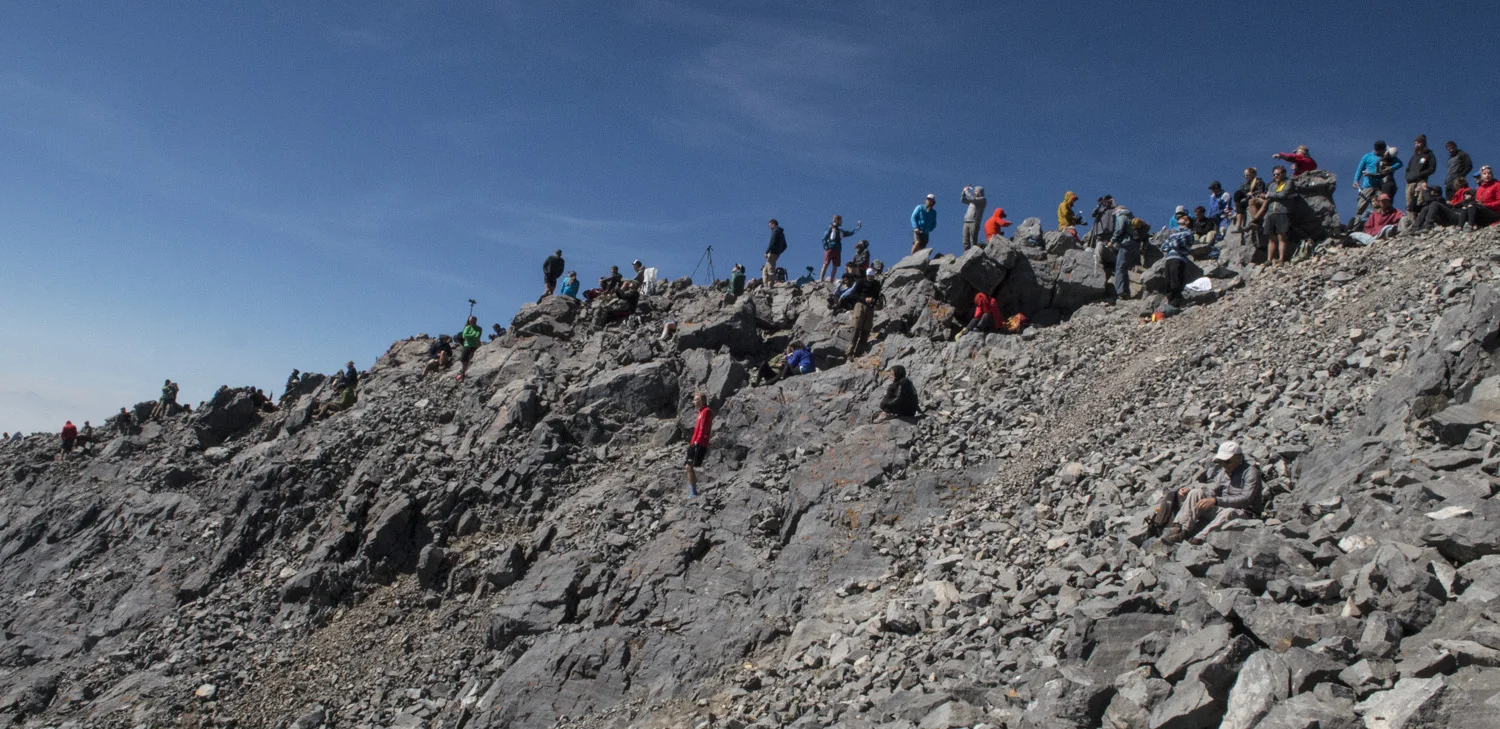
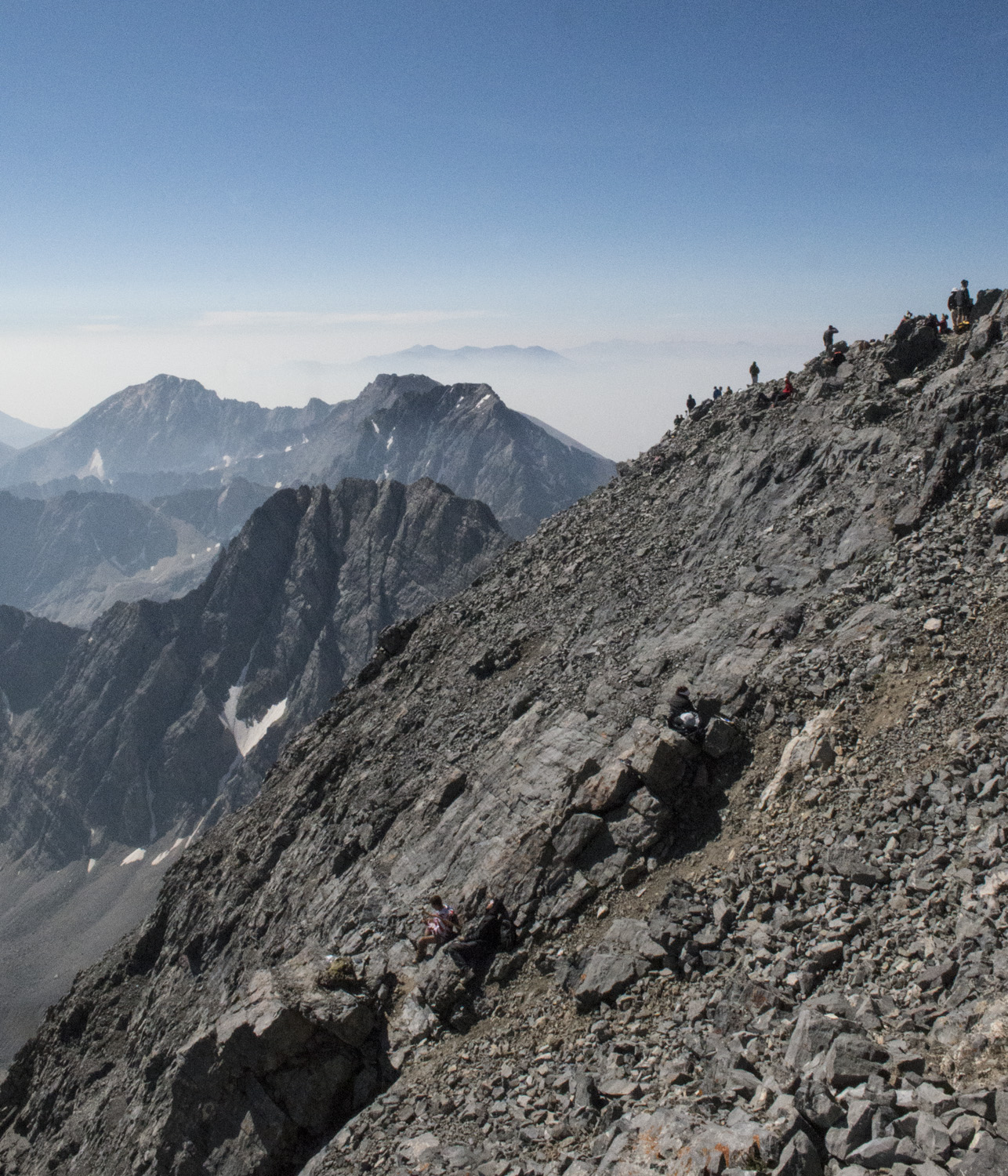
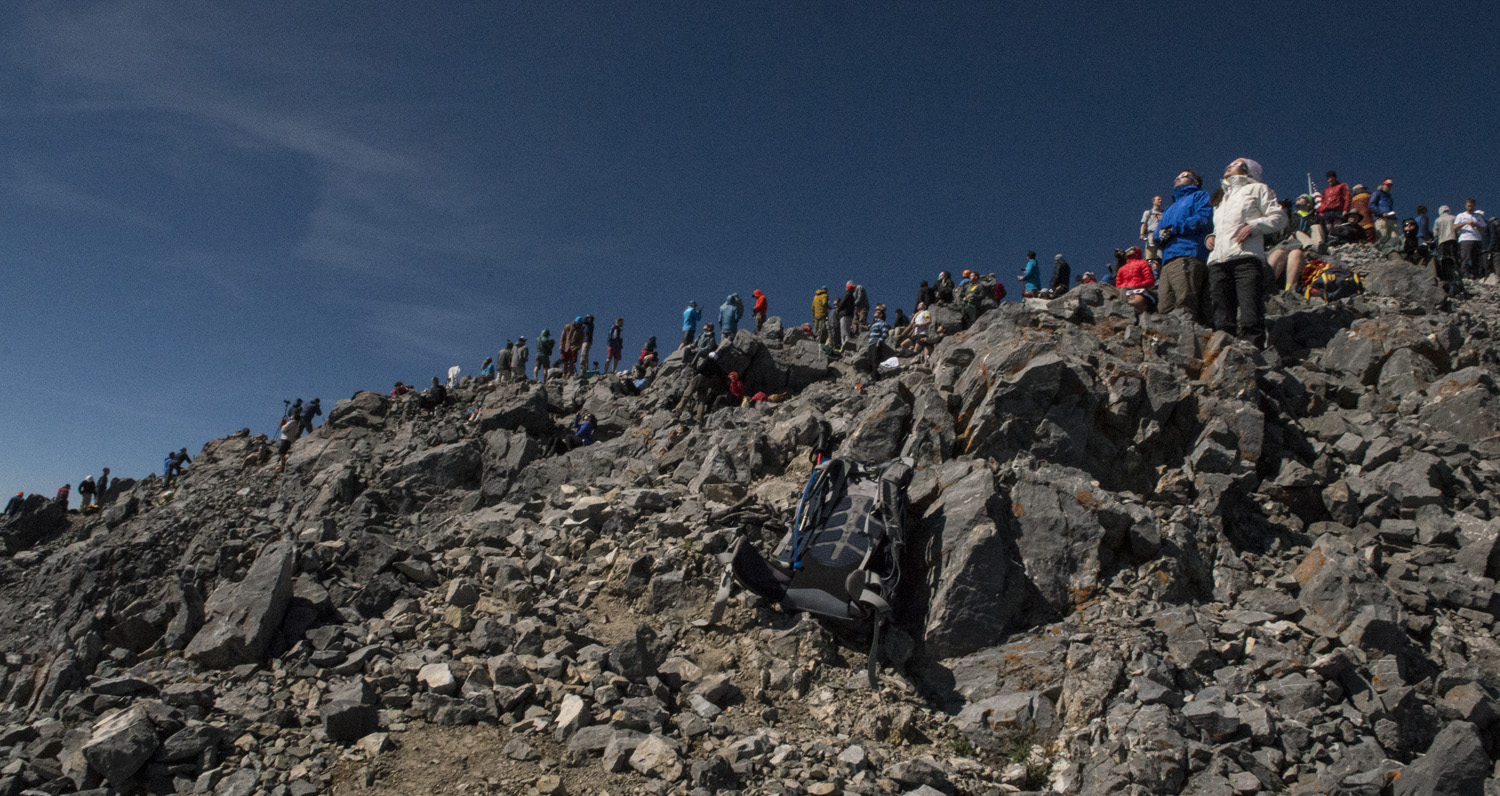
I would estimate there were between 100 and 150 people on the immediate summit area by the time first contact occurred around 10:30. While the summit area isn’t huge, there was plenty of room for all that showed up, with many setting up along the ridge that ran south of the summit for about 100 feet. I had settled on a spot on the eastern slope of the summit, just above the cliffs.
Check out the video below from YouTube user montagnadilombardia for some breathtaking drone footage of the crowd on the summit of Mount Borah gathering for the eclipse. I'm in there somewhere! It also has shots showing the hike down. Watch on a really big screen if possible.
At one point after the eclipse had started (but well before totality) I decided to shoot some selfie video, just some travelogue stuff. As I'm shooting, I start to hear people getting excited behind me. I turn around and see a man near the summit marker addressing the crowd. Turns out it was his speech before proposing to his girlfriend. She said yes! And here I had been feeling a little anxious hoping it was a good day just so I could take some pictures, this guy was making a life changing decision! Congratulations to the happy couple!
The following video is from the first half of the eclipse (pre-totality) and includes the proposal!
Everyone was in a festive mood, anticipating totality. Unless special eclipse glasses were being worn it was hard to tell that anything was happening at all for most of the eclipse. It wasn't until the eclipse was at about 80-90% that things started getting interesting. The light began to look... weird. Everything took on an erie grayness, not quite daylight, not quite shade. And it started cooling down. Everyone, almost in unison, began reaching for another layer to put on.
ECLIPSE: YEARS OF PLANNING FOR TWO AND A HALF MINUTES OF GLORY
The total eclipse was now moments away. Those on the summit ridge and western slopes of the summit were able to watch as the moon’s shadow come into view on the horizon and swept across the hazy Idaho landscape thousands of feet below us. As the leading edge raced across the valley floor the energy in the crowd became palpable. The “oohs”, “aahs”, and “oh my gods!” built to a crescendo until finally the totality engulfed the mountain and the crowd burst into thunderous cheers and applause.
Check out the video below from YouTube user Spencer Ball for an amazing view of the totality approaching Mount Borah.
And there it was. An absolutely perfect total solar eclipse. A pitch black moon radiating milky white tendrils across a deep blue sky. There was no need for the special glasses anymore, you could look at it now with the naked eye. The darkness that consumed the region was sudden and dramatic. It was like someone just shut the lights out. At its height the darkness extended for three dozen miles all around us. Where the darkness ended on the horizon there were the yellow hues of a fading sunset, except it looked like a sunset in every direction.
The eclipse from the summit of Mount Borah
I had no time for gawking though. Seconds after totality started, I began shooting for my panorama. Years of planning came down to a two minute window of time in which I had to get all the shots that I needed. As far as shooting it, I really didn’t know what to expect until I was in the situation. I knew how many degrees above the horizon it would be, but didn’t know what that would actually look like. I normally shoot one pass of wide angle, horizontal images all around me for a panorama, maybe a dozen frames. However, the eclipse was just high enough where I couldn’t get it and the ground in the same shot at the same time. So I had to go vertical, which I had never done before. I ended up making three passes of vertical shots to make sure I had the coverage. About 80 shots in total, all in two minutes and all hand held. I opted not to bring my tripod since I didn’t want to carry the extra weight. As I was frantically pivoting and shooting away, I had one big balance check as I stumbled slightly, enough to alarm an onlooker near me. I recovered quickly and kept shooting.
As far as the exposure goes, I didn’t know what to expect from that either. As the eclipse passed the 80% mark I had to start adjusting my exposure to compensate for the darkness. It still took me by surprise just how dark it got when totality hit. Luckily the light was even in all directions so once I saw my histograms were good I could just concentrate on shooting. I ended up shooting everything at f7, 1/100, and ISO 4000.
Once I felt I got what I needed, I had a few short moments to just stand there and watch it. It was truly amazing. Such a simple thing, yet so extraordinarily beautiful. At the last second I picked up my camera and got my only close up of it. I was able to capture the “diamond ring” effect which is visible at the beginning and end of totality.
The last moments of the totality as the sun reemerges.
After a far too short two and a half minutes, totality ended and the sun reappeared, returning light and warmth to all the revelers who had made the trek up Mount Borah. As we all stood around grinning like fools trying to wrap our heads around what we had just witnessed, we watched the moon’s shadow slide away toward the horizon, heading for Wyoming and points east. And like that, it was over.
The following video is my post eclipse reaction.
DESCENT: LONG WAY DOWN
The crowd that had gathered largely dispersed after totality ended. I hung around for a while. After all the planning and effort to get up here I wanted to enjoy it. And I wasn’t feeling any altitude sickness so I wasn’t in a hurry to get down. People who had watched the eclipse from the lower ridges of the mountain continued to summit for a while. I would take their cell phones and take their pictures while they posed on the summit. I even shot one family as part of one of my panoramas.
Around 2:00 p.m. I started the long trek back down the mountain. Weird to think of less than four miles as a long trek. I can normally do ten miles in about four hours at my hiking spots around Syracuse. The steepness of the hike kept me to a snail’s pace. A little down slope is nice, a lot isn’t.
Just before crossing the snow couloir I saw a familiar face. I walked up to him and said “you’re from the club aren’t you?” Sure enough, it was highpoint club member Sjaak Van Schie. He had come here from his home in the Netherlands for the eclipse. I had seen him at the conventions and had spoken to him once or twice. He was on his way up to the summit. He asked what my plans were that evening and that he was staying at a hotel back in Arco with a friend. They had an extra bed in the room and I was welcome to it. I had no plans other than to start heading south back towards Utah. I kindly took him up on the offer. We would meet up later.
Me and Sjaak meeting up near the snow bridge
I continued down the mountain. I passed several groups also heading down that looked like they were having a hard time of it. The steepness of this mountain should not be underrated. I developed some hot spots on my big toes. I stopped to put some pads on them before they turned into blisters.
The hike down was a whole new experience form the hike up, since I could now see what lay ahead of me. It definitely felt longer going down, but I also had amazing views now in the daylight. I could now see the full magnitude of that shear drop off at the ridgeline that I had only glimpsed earlier with my headlamp. Didn’t want to have a misstep there. And the woods below treeline had a whole different feel. Previously concentrating only on the trail in my headlamp, I hadn’t noticed how gnarly and twisted the trees really were. Like something out of a horror movie.
The following gallery is from the hike back down to the trailhead. Most of the descent was like a brand new hike, as I'd not been able to see any of the views on the way up.
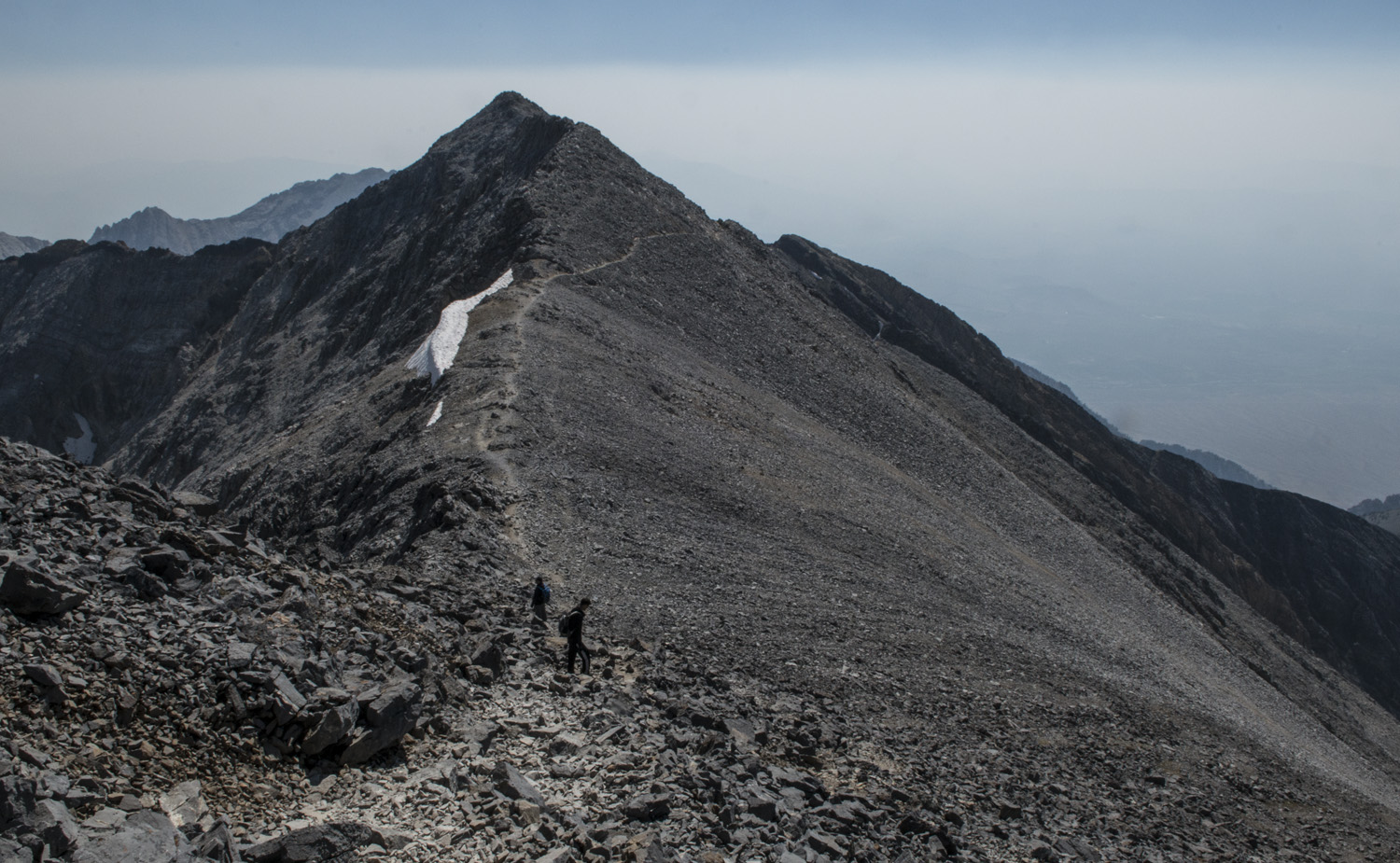
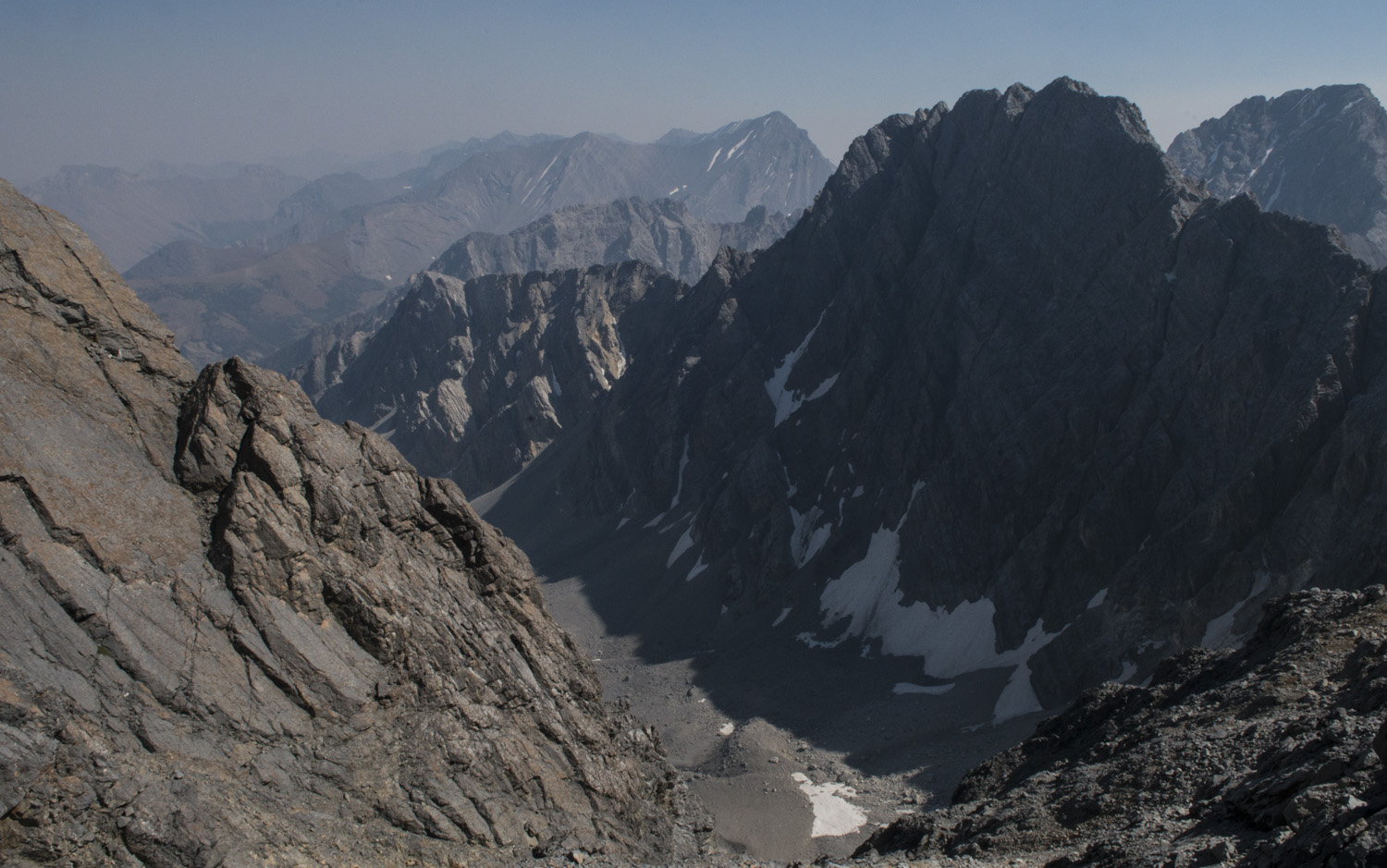
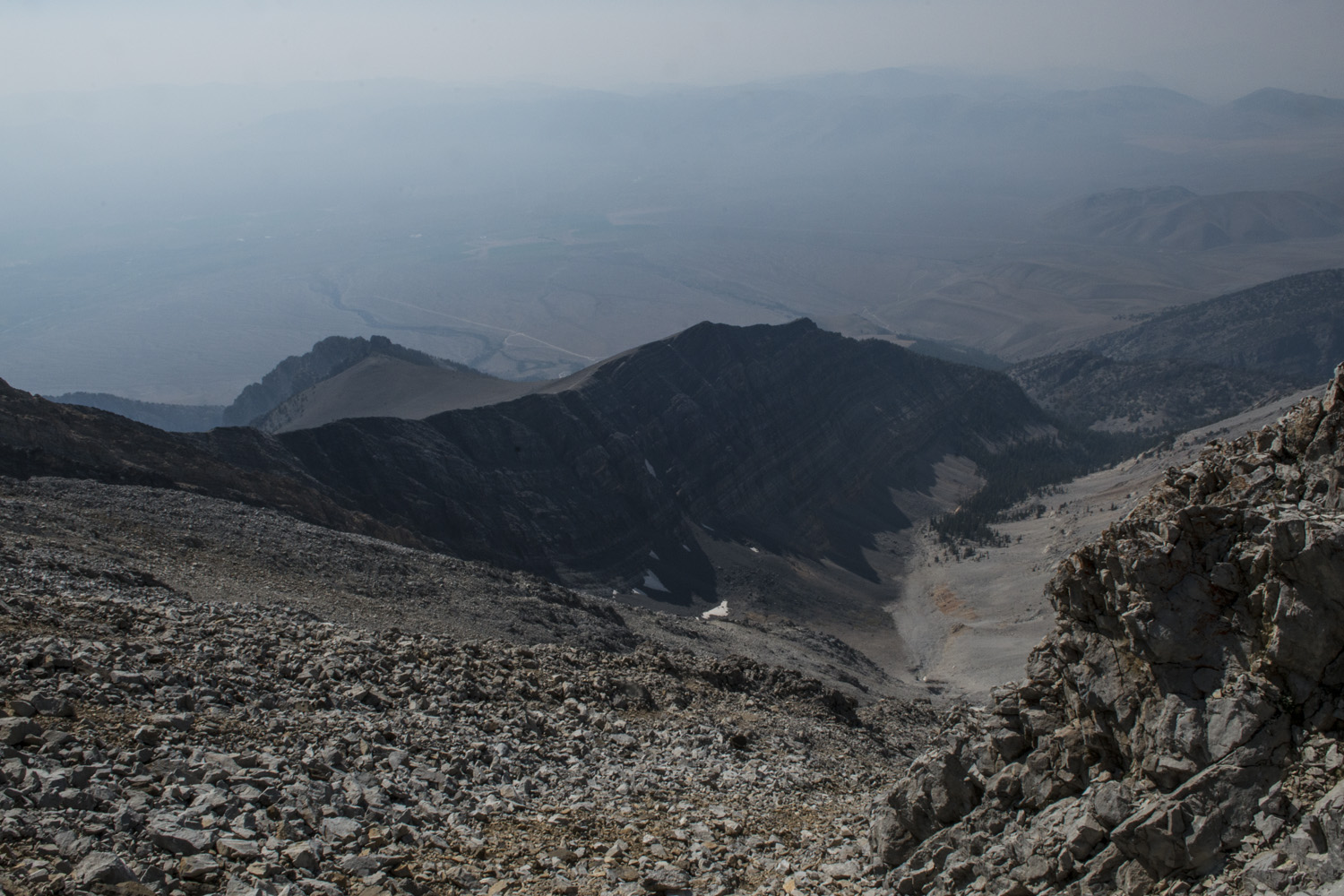
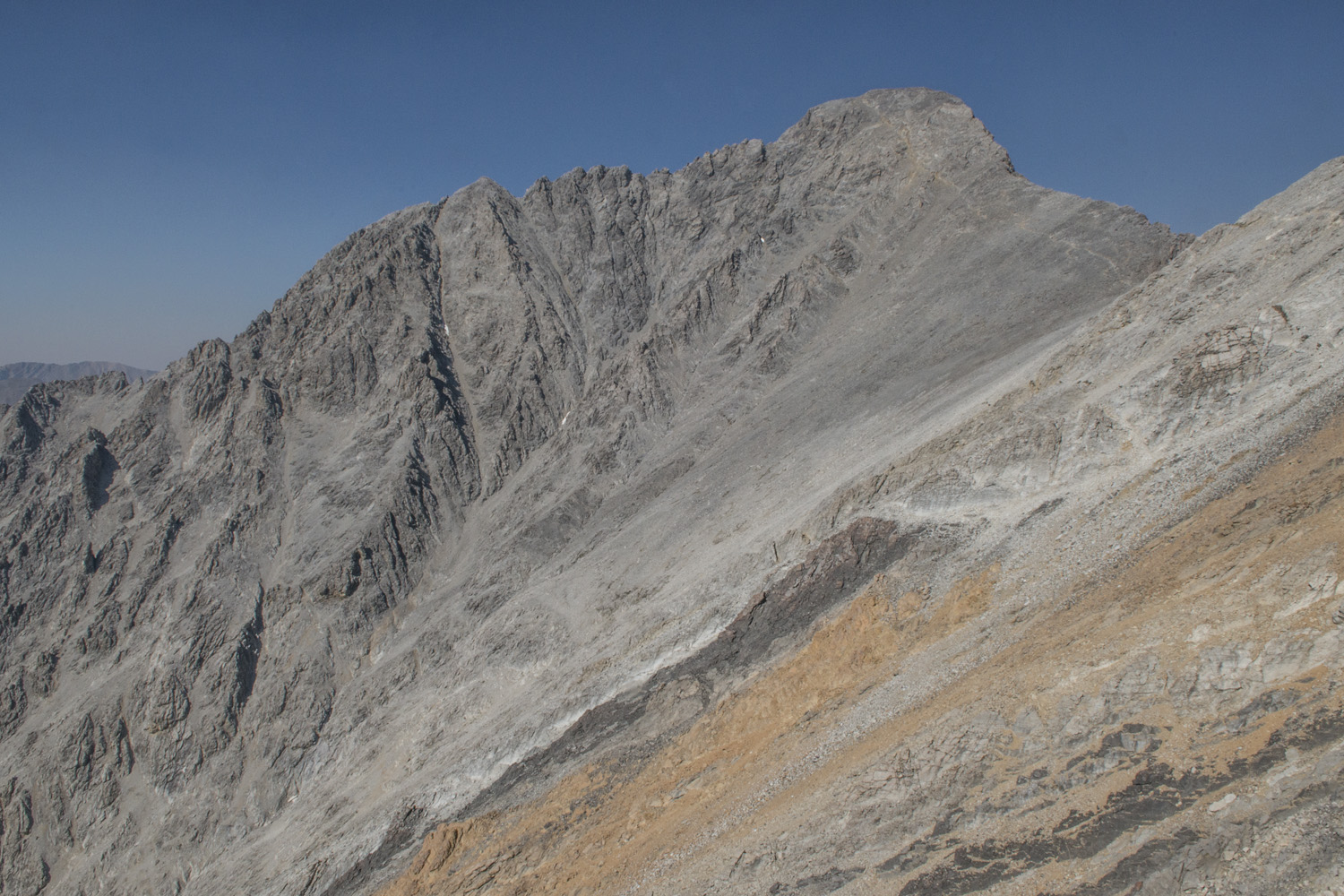
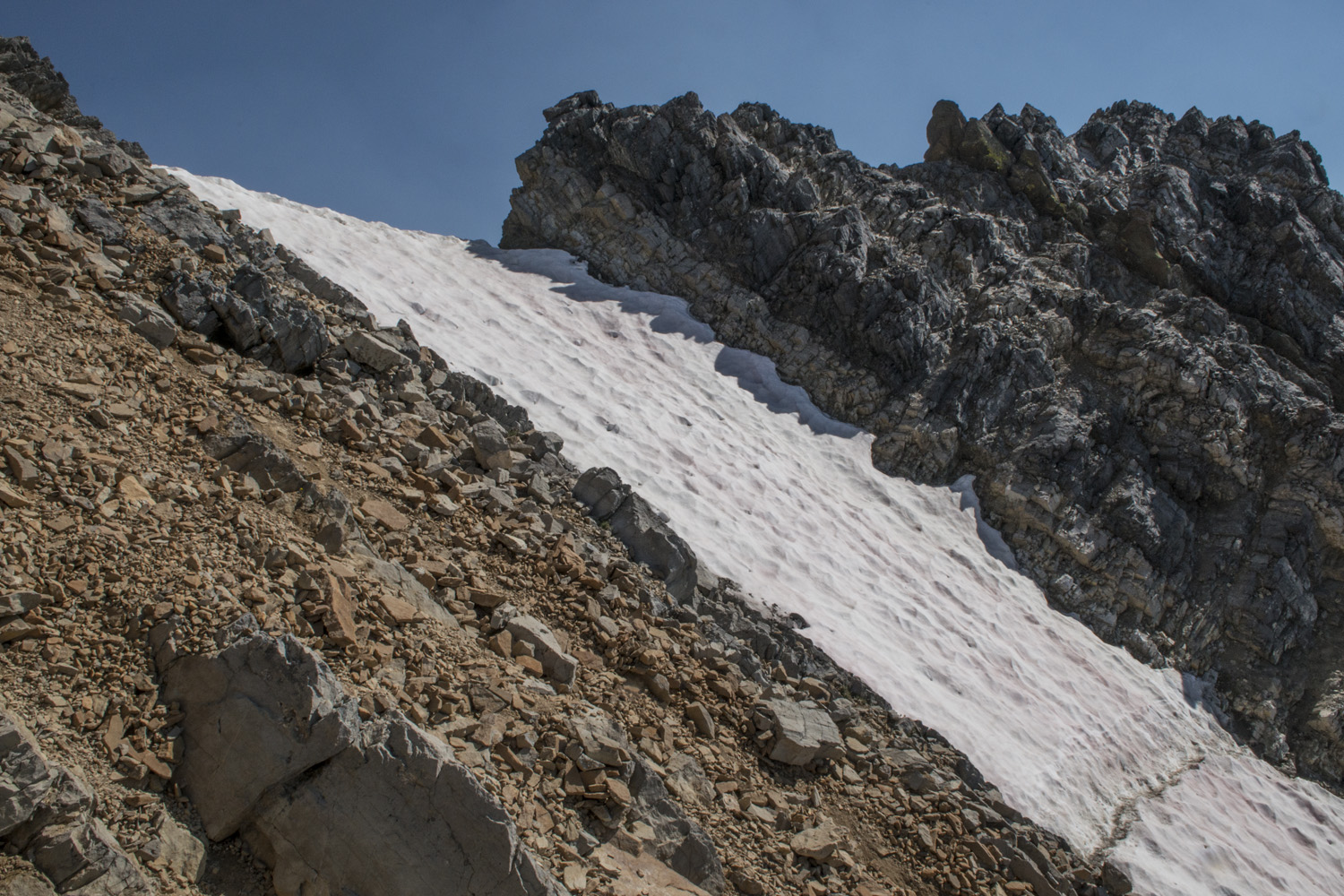
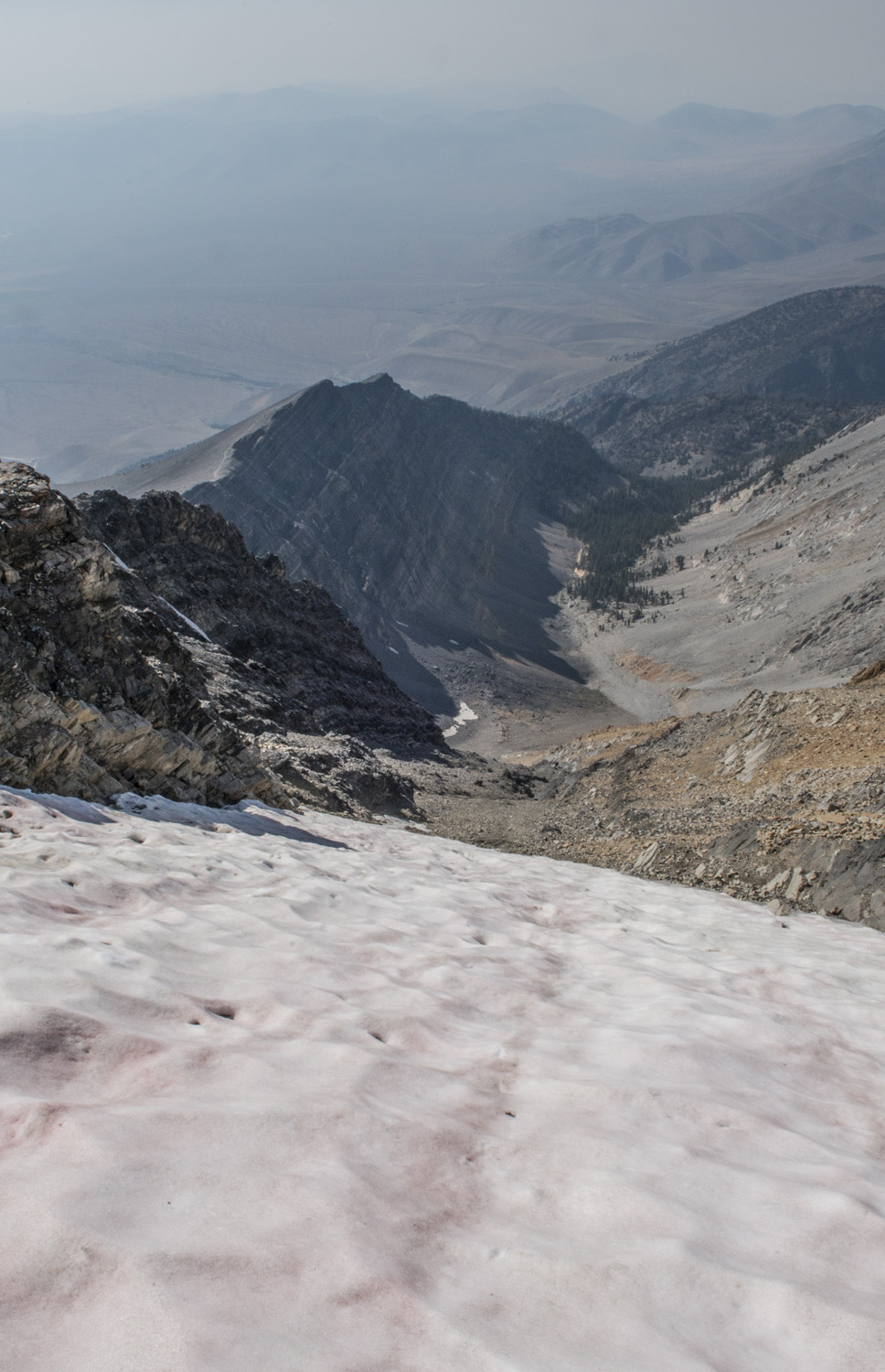

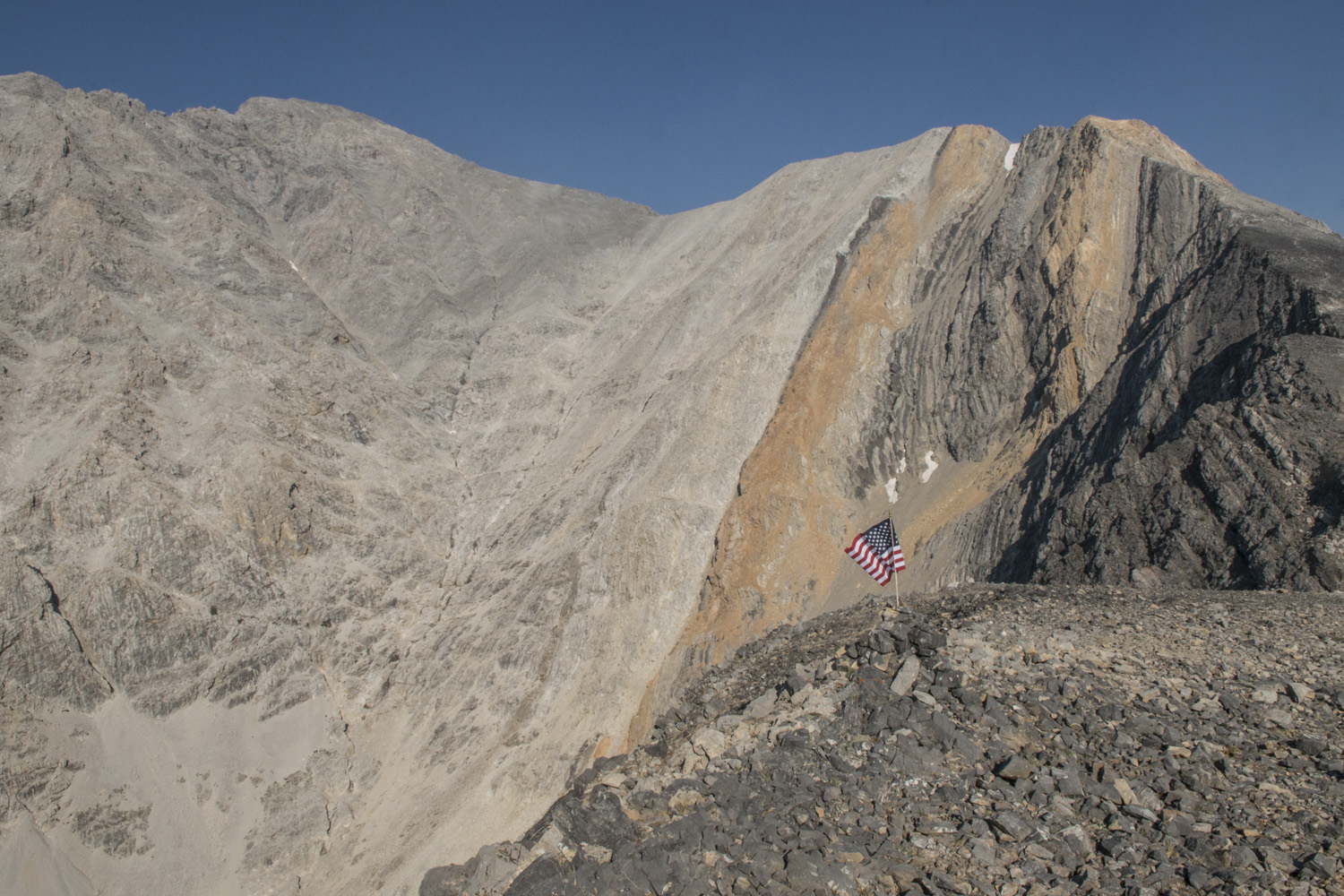
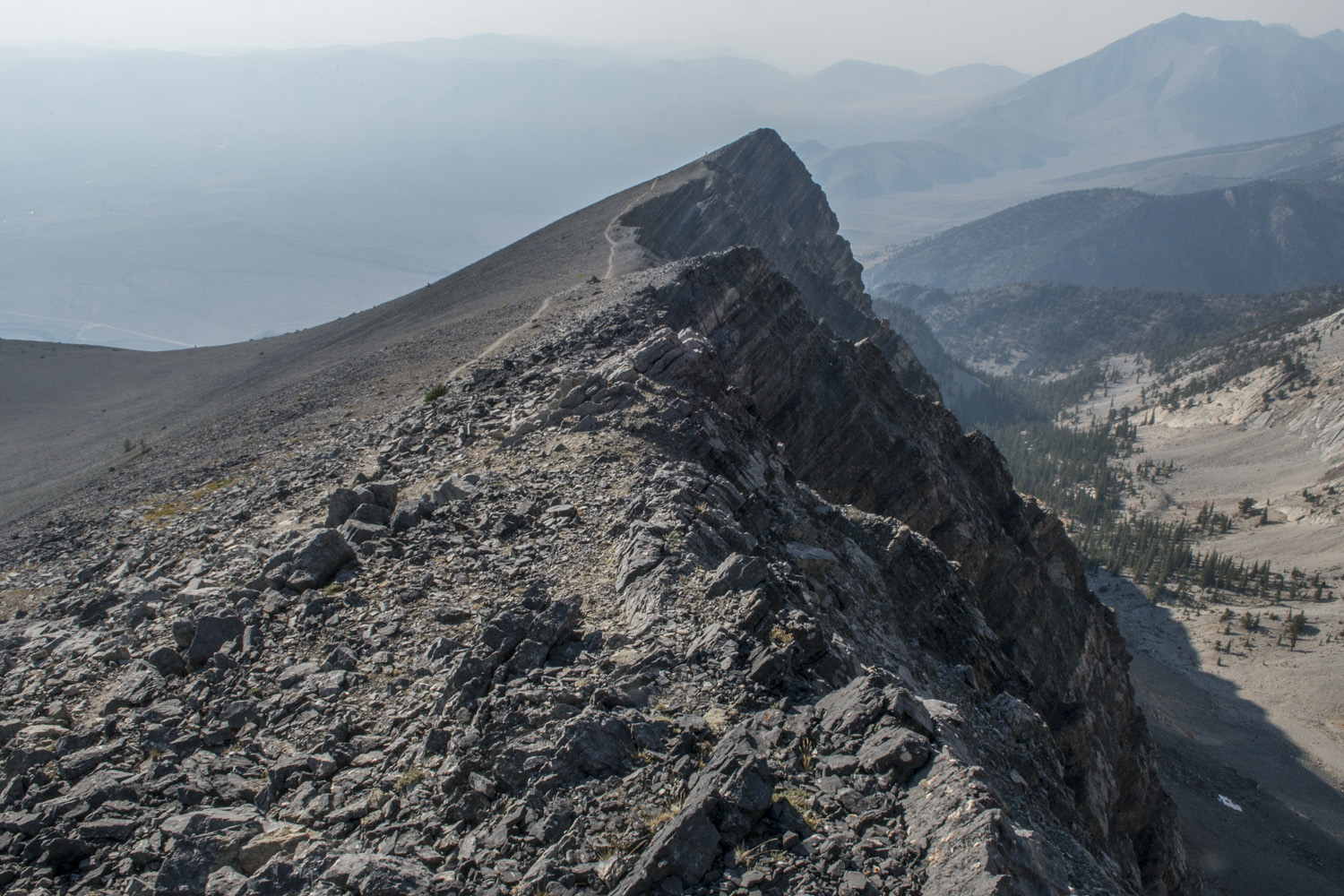
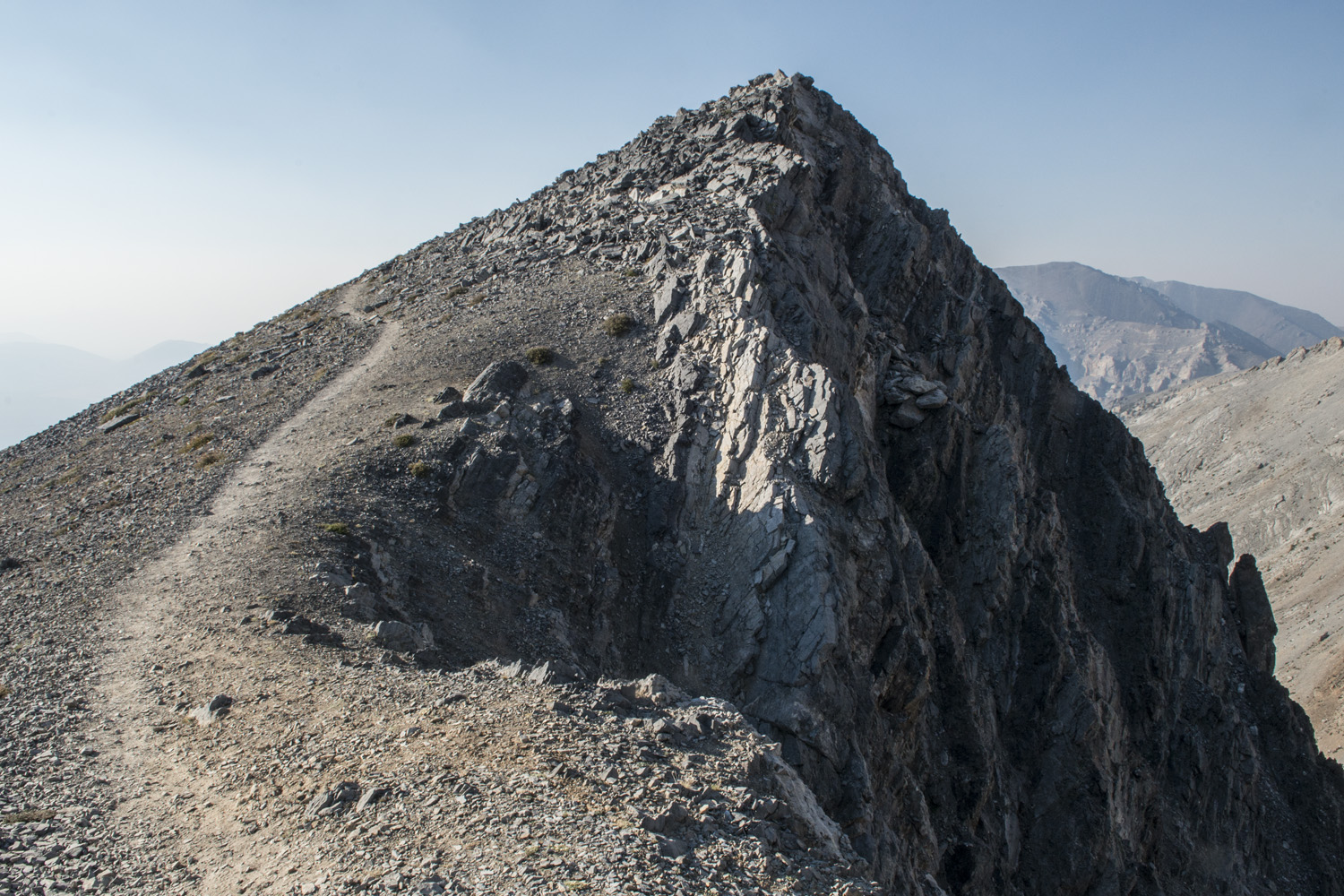

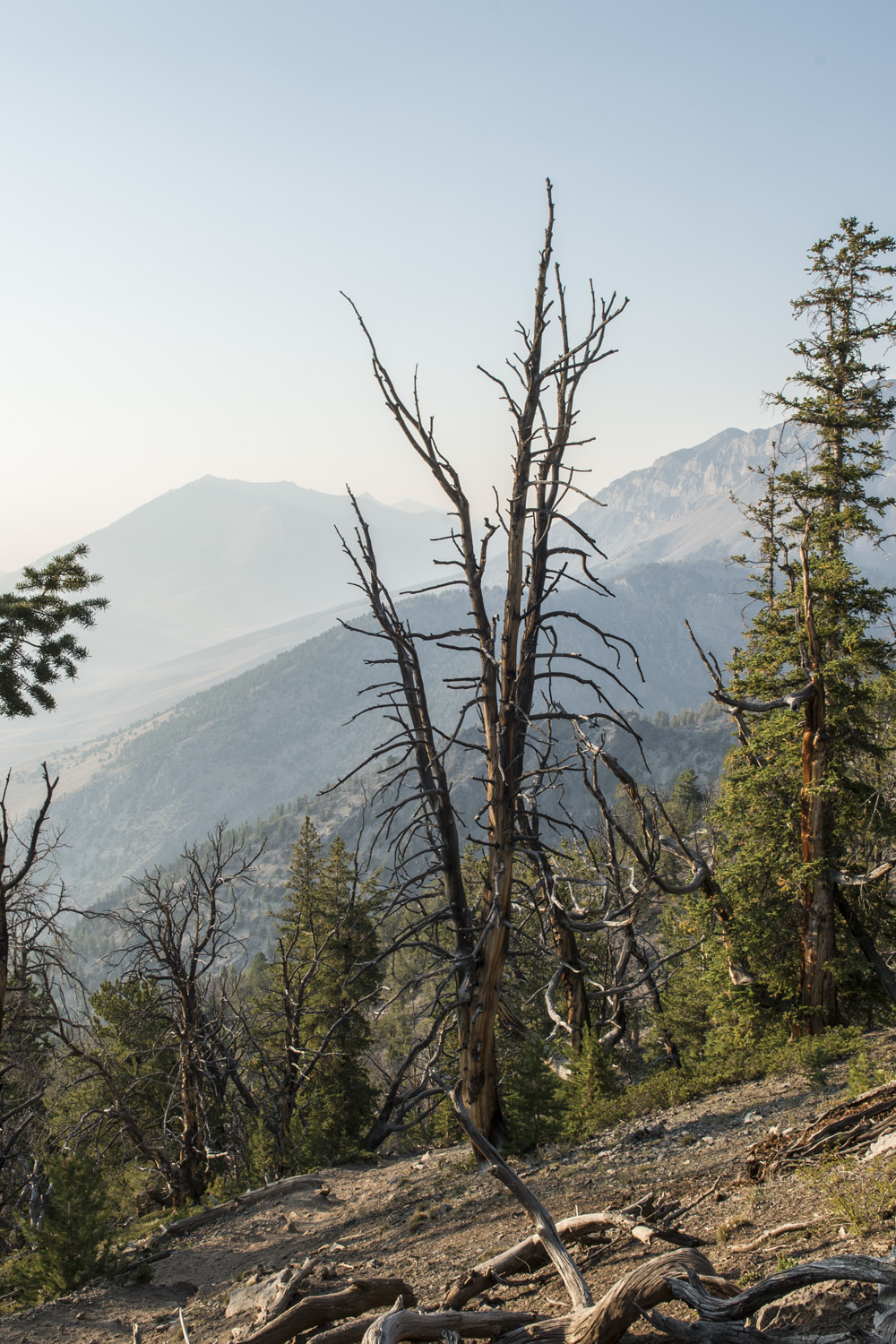
To show how slow I was going, Sjaak, who i met while he was on the way up and I was headed down, passed me in the woods on his way down. He was practically galloping down. My knee and toes simply weren’t going to let me go that fast. So we met up once I got back to the trailhead. The sun just disappeared behind the horizon as I took my last steps off the trail.
The final stretch before sunset. I made it to the trailhead mere seconds after the sun totally disappeared over the horizon.
EPILOGUE: REST AT LAST
I followed Sjaak back to Arco where we stopped for a bite to eat at a diner. A burger and fries never tasted so good. We went back to the hotel, where I met his friend Sharmon. We all talked about our adventures during the day. I took a shower, my first one in two and a half days. I finally laid down in bed around half past midnight, 24 very long hours after I had first gotten up to start getting ready.
This was such an amazing experience, one that I won’t soon forget. I got to witness one of the most awe inspiring events in nature, and claim my 27th highpoint in the process! Now to start planning for the 2024 eclipse!
Other posts in this series:
Great Basin National Park, Nevada. An Unexpected Journey.
White Butte, Highpoint of North Dakota. Really? More Goats?
Mount Katahdin, Highpoint of Maine. If At First you Don't Succeed...
Hawkeye Point, Highpoint of Iowa. So... Much... Corn...
Granite Peak, Highpoint of Montana. I Have Seen The Top Of The Mountain, And It Is Good.
Mount Borah, Highpoint of Idaho. The Great American Eclipse Of 2017.
Tri-Point Of Iowa, Nebraska, And South Dakota. Hot. Damn Hot. Real Hot.
Sassafras Mountain, Highpoint of South Carolina. Please excuse our mess.
Ebright Azimuth, Highpoint of Delaware. Rock bands and space shuttles.
Charles Mound, Highpoint of Illinois. A farmland stroll.
Tri-point of NC, TN, and VA. My car meets its match.
Mount Rogers, Highpoint of Virginia. OH MY GOD!!! LOOK AT ALL THE FUZZY PONIES!!!
Guadalupe Peak, Highpoint of Texas. Birth of an obsession. And big freaking bugs.







